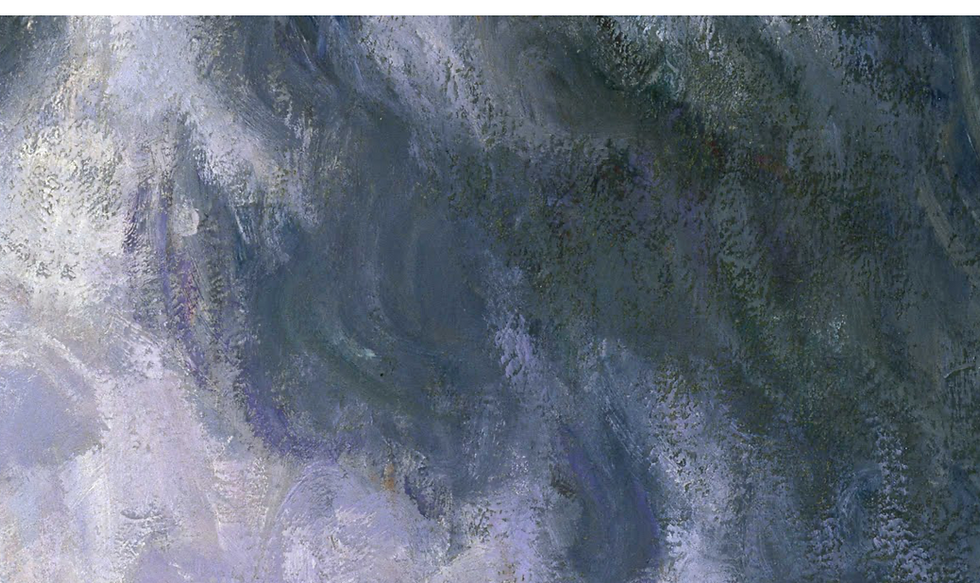The Whites: Pigments, Techniques, and Masterpiece Analysis Through the Age
- Mestan Tekin
- Dec 12, 2024
- 8 min read
White pigment might seem like a quiet constant in an artist’s palette, but it’s actually a fundamental and complex element that’s evolved through the centuries. It plays a key role in shaping light, creating textures, and defining tonalities in a piece of art. In this article, I’m diving deep into the different whites—exploring their historical origins, technical uses, and highlighting key examples of major artists who’ve mastered these pigments to elevate their creations.
This review article aims to deepen our understanding of how crucial white pigments are in the artistic process, with a focus on the ever-important titanium white and its place in today’s more limited palettes, where permanence and stability are key

Lead White (Lead Carbonate - PbCO₃)
History and Manufacturing Process
Lead white, also known as ceruse, is one of the oldest white pigments used in painting. Its production dates back to Greco-Roman antiquity, where the so-called "stacking" method was used. Lead sheets were coiled into spirals and placed in pots filled with vinegar. These pots were then buried in manure or organic waste, creating a warm and humid environment. The lead reacted with the acetic acid vapors to form lead carbonate... and voilà, white!
Chemical and Physical Properties
Opacity and Brightness: Lead white is super opaque and gives off a warm luminosity.
Texture: It has a creamy consistency, perfect for impasto and subtle blending.
Toxicity: Highly toxic—can cause lead poisoning if handled improperly (don’t worry, there’s none of this in the studio!).
Stability: Tends to blacken in the presence of sulfides, which can alter the artwork over time.
Titanium White (Titanium Dioxide - TiO₂)
History and Manufacturing Process
Titanium white, discovered in the early 20th century, became the most widely used white pigment in painting post-WWII. It’s produced through modern chemical methods like the sulfate or chlorine process, extracting and purifying titanium dioxide from minerals like ilmenite. This pigment quickly replaced lead white due to its non-toxicity and exceptional performance.
Chemical and Physical Properties
Opacity and Brightness: Titanium white is ultra-opaque, giving off a pure white that offers fantastic coverage and brilliant light.
Texture: Dense and slightly paste-like, it’s great for solid coverage but less suited for fine glazes.
Toxicity: Non-toxic, making it a safer option for modern artists.
Stability: Extremely stable, resistant to light and chemical elements, and doesn’t yellow with time, making it a durable pigment for artwork.
Titanium white checks all the boxes for being the ideal white in a long-lasting, efficient palette. It’s the one you’ll find on your studio palette.

Cracks in Zinc White
Zinc White (Zinc Oxide - ZnO)
History and Manufacturing Process
Zinc white was introduced in the 19th century as an alternative to lead white, in response to growing concerns over lead toxicity. It’s made industrially through the calcination of zinc ore, where zinc is heated to form a fine white powder of zinc oxide. While less opaque than titanium white, it quickly gained popularity due to its unique properties.
Chemical and Physical Properties
Opacity and Brightness: Semi-opaque, offering a cool, soft brightness perfect for subtle and transparent effects.
Texture: Light and fluid, it’s ideal for glazes and delicate blending.
Toxicity: Considered non-toxic, it’s safe to handle, though it’s less stable when mixed with oily mediums.
Stability: While lightfast, zinc white can become brittle in thick paint films, leading to cracking over time.
Zinc white is prized for its delicacy and transparency, making it a go-to for glazes and detailed work, complementing other whites in an artist’s palette.
Whites Through the Centuries
Italian Renaissance


Leonardo Da Vinci - The Last Supper
In this iconic fresco, despite its deterioration, Leonardo used lead white to create effects of light and volume on the figures. His sfumato technique, which involves softening edges to create smooth transitions between tones, relied heavily on mixing lead white with darker pigments.
Technical Analysis:
Tone Modulation: Lead white allowed Leonardo to create subtle gradations in the drapery and flesh tones.
Brightness: It enhanced the illuminated areas, guiding the viewer’s gaze to the faces and gestures of the apostles.
Support Preparation: Leonardo experimented with a mixed technique, combining tempera and oil, where lead white played a crucial role in the underpainting, reflecting light through the upper layers.

Titian - Venus of Urbino
Titian - Venus of Urbino
Titian is known for his mastery of color and texture. In Venus of Urbino, he used lead white to create luminous, sensual flesh tones.
Technical Analysis:
Glazing: Fine, semi-transparent layers of paint were applied, with lead white mixed with reds and yellows to achieve realistic flesh tones.
Texture: Lead white gave the paint a creamy consistency, helping smooth transitions between light and shadow.
Inner Light: Titian created an impression of light emanating from within the subject, thanks to the reflective properties of lead white beneath the colored layers.
Flemish Baroque

Rubens - The Elevation of the Cross
Peter Paul Rubens, a major figure of the Baroque, used lead white to amplify the dynamism and theatricality of his compositions.
Technical Analysis:
Impasto: Thick applications of lead white accentuated light areas, creating physical relief on the canvas.
Contrasts: Lead white contrasted with deep shadows, intensifying the chiaroscuro effect.
Chromatic Mixing: By blending lead white with colored pigments, Rubens achieved colorful light effects, adding richness to his palette.
The Royal Museums of Fine Arts in Brussels boast an incredible collection of works by Rubens and his workshop—definitely worth a visit! You’ll also find Rubens shining in other collections across Belgium and at the Prado in Madrid. Get up close to his paintings and take a good look at the pigments, the texture, and those brushstrokes. It’s pure magic in motion!

Rembrandt - The Night Watch 
Rembrandt - The Night Watch
Rembrandt - The Night Watch
Famous for his mastery of light and shadow (chiaroscuro), Rembrandt used lead white to model forms and direct attention in The Night Watch.
Technical Analysis:
Sculptural Impasto: Thick layers of lead white highlighted areas like costumes and faces, reflecting light.
Mixing with Ochres: Lead white was mixed with natural earth pigments to create warm flesh tones.
Durability: Rembrandt’s deep knowledge of materials helped minimize lead white’s darkening over time, ensuring better preservation of his works.
French Impressionism


Manet - Le Déjeuner sur l'Herbe
As a precursor to Impressionism, Manet used zinc white to capture natural light effects.
Technical Analysis:
Transparency: Zinc white, less opaque than lead white, allowed for subtle layering to depict light filtering through foliage.
Light Palette: The luminosity of zinc white was used to accentuate the contrast between light and shadow.
Light Textures: Zinc white added a lightness to the painting, fitting with the Impressionist focus on spontaneity.

Monet - Water Lilies 
Monet - Water Lilies
Monet - Water Lilies
Monet’s Water Lilies series explores light and color, with zinc white playing a key role in creating atmospheric effects.
Technical Analysis:
Atmospheric Effects: Zinc white was used to create veils of color, replicating reflections on water.
Optical Mixing: By juxtaposing touches of white with pure colors, Monet allowed the viewer’s eye to mix the hues, enhancing the sense of light vibration.
Brush Economy: Zinc white enabled Monet’s quick, light brushstrokes, capturing the fleeting moment.
Abstract Expressionism

Willem de Kooning - Woman I
De Kooning, an Abstract Expressionist, used titanium white for its density and ability to withstand repeated layering.
Technical Analysis:
Coverage: Titanium white allowed de Kooning to layer over previous marks, giving flexibility in his creative process.
Thick Texture: By applying thick impasto, de Kooning added physical presence to the canvas.
Chromatic Contrast: The pure white created striking contrasts with vibrant colors, energizing the composition.

Pollock - Number 1A, 1948
Jackson Pollock - Number 1A, 1948
Known for his dripping technique, Pollock used titanium white to balance his compositions.
Technical Analysis:
Fluidity: Diluted titanium white was splattered or dripped, creating lines and splashes of light.
Visual Balance: White highlights contrasted with darker colors, adding depth and avoiding visual saturation.
Layering: White was used throughout the layers, enriching the texture of his works.
Contemporary Art

Anselm Kiefer - To the Unknown Painter
Kiefer used titanium white to create complex textures and surfaces full of meaning.
Technical Analysis:
Materiality: White was mixed with unconventional materials (straw, lead, ash) to add tactile depth.
Symbolism: The white symbolized both purity and absence, reinforcing themes of memory and history.
Thick Layers: Accumulated layers of white created reliefs, playing with light and shadow.

Saville - Plan
Jenny Saville - Plan
Known for monumental depictions of the human body, Saville uses white to accentuate volumes and imperfections in the skin.
Technical Analysis:
Body Modeling: Titanium white mixed with flesh tones to create reliefs and highlight light areas.
Expressivity: Thick applications of white add emotional depth to her subjects.
Modern Approach: Saville’s use of white challenges traditional aesthetic norms, making a statement in contemporary art.
Mastering the Art of Whites: Techniques and Trends in Modern Painting
Oil Painting
Base Layers and Priming
Lead White: The OG of undercoats—stable, versatile, and reflective. It enhances luminosity by bouncing light through top layers.
Pro Tip: Mix lead white with a touch of pigment to create tonal priming for a seamless, harmonious vibe.
Mixing and Modulating Tones
Titanium White: The heavyweight champ for coverage—perfect for bright highlights or touch-ups.
Zinc White: Think subtle and smooth. Ideal for soft blends and transparent glazes.
Textures and Impastos
Application: Titanium white’s thick texture makes it the go-to for bold impastos and dimensional effects.
Why It Rocks: Impastoed whites catch the light and add next-level depth to your canvas.
Watercolor and Gouache
Light Tricks
White Paper Magic: In watercolor, the untouched white paper is your light source. Reserve those highlights!
Chinese White (Zinc White): For detailed highlights or quick fixes in gouache or opaque watercolor.
Soft Pastels
Titanium White Gouache: Mix it with pigments for dreamy pastel shades that pack an opaque punch.
Transparency Game: Adding white reduces translucency, opening up new creative approaches.
Acrylic Adventures
Layering Like a Pro
Zinc White: Your secret weapon for light, transparent glazes. Layer it up without losing what’s beneath.
Titanium White: Go bold with opaque applications or fix those tricky mistakes.
Mixed-Media Power Moves
Mediums: Mix white with acrylic mediums to tweak consistency and transparency.
Textures: Combine titanium white with gels or texture pastes for bold 3D effects.
Pastel Magic
Highlights and Reflections
White Pastels: Essential for capturing light and adding shimmer.
Blend It: Mix directly on the surface to create nuanced tones and gradients.
Depth and Atmosphere
Layering: Add white over dark shades to create misty, ethereal vibes.
Pressure Play: Vary intensity with pressure for ultimate control.
Fresco & Mural Vibes
Lime White
What It’s Made Of: Calcium hydroxide, a staple for fresco techniques with durable chemical properties.
How It Works: Applied wet, it reacts with the plaster for a lasting, luminous finish.
Mineral Pigments
Built to Last: White mineral pigments stand strong against humidity and the test of time.
Iconic Moments: Check out Michelangelo’s Sixtine Chapel frescos for peak white pigment usage.
Conservation & Restoration
When Whites Go Rogue
Lead White: Prone to darkening when exposed to hydrogen sulfide—handle with care.
Zinc White: Delicate and prone to cracking, especially when layered too thickly or in slow-drying oils.
Fixing the Past
Cleaning: Knowing the composition of whites used is crucial to avoid damage during restoration.
Color Matching: Restorers use compatible pigments to touch up damaged areas without compromising authenticity.
Why Whites Matter
White pigments are the unsung heroes of art. From shaping light and space to adding depth and texture, they’re essential for bringing artistic visions to life. Whether you’re inspired by the classics like Leonardo da Vinci or pushing boundaries like Jenny Saville, understanding whites unlocks infinite creative potential.
Got questions or want to dive deeper into the world of whites? Let’s chat during a workshop, in the comments, or by email. And don’t forget to check out the list of painting courses on the studio page!



Comments